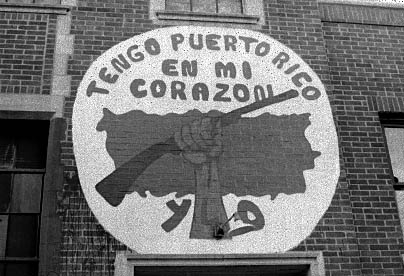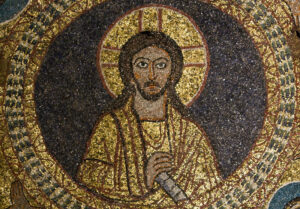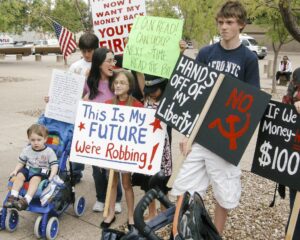The struggle for self-determination, liberation, and love took on many forms in the late 1960s. One form was the radical action of the Young Lords, a Puerto Rican revolutionary group who advocated for Puerto Rican self-determination and a world organized by a principle other than the idolatry of money. Initially a gang in the Lincoln Park neighborhood of Chicago, the Young Lords reconstituted itself as a consciously political organization in 1968. The Lords eventually grew to a multi-chapter movement spanning across the East Coast, including to New York City where a large group of Puerto Ricans lived, and began their political organizing by going directly to the people to address needs being ignored in their own communities. The Young Lords embodied the values of the Christian call to stand in solidarity with the poor and to stand against poverty, as opposed to those who claimed to be Christian but remained indifferent to the plights of the poor.
The Young Lords’ commitment to fight poverty and racism resisted a politics of respectability that plagued many Christians in the era when the Lords were active. Most Christians gathered on Sundays in churches but left these spaces empty the remaining days of the week. Though these Christians would create hospitality teams and lead service projects for their congregants, they often did little to fight against the conditions that created widespread poverty. Their politics was inward-focused. Insular. In contrast, the Young Lords focused their efforts in an external direction toward their community members whom they passed each day taking the train, working, or going to school.
Such an attention to one’s community necessarily provokes questions. What needs of the community can be satisfied with the church’s resources? What are vulnerable congregants not getting that could be provided Monday after congregants say the benediction?
Many Christians still operate with a politics of respectability that forecloses the revolutionary potential of church spaces. They attend each week hoping for a sermon, asking for prayer, hoping to be uplifted for another week of mundanity, but see the church as a medium for nonpolitical religious life. In fact, what Christianity represents for many churchgoers is an escape from politics or the material; as such they miss the ways the gospel proclaims a God who is concerned with both the material and the spiritual. One consequence of this disjunction has been that organizers on the left often don’t consider organizing possibilities latent in church spaces. They see church as but one context that keeps working class and marginalized people disinterested in social change, or they see the church as an ideological tool of the existing neoliberal hegemony.
The story of the Young Lords pushes back against the reductions of both respectable Christians and critical organizers. The Lords’ attention to building coalitions among the working class and their utilization of churches for politically-conscious organizing spaces are practices the left can and should adopt for social change.
“To Be and Not Wanting To Be…That’s the Currency”
The Young Lords emerged within the melancholia of the lingering effects of their colonial history, whether on the island or “stateside.” Stateside, white New Yorkers cast Puerto Ricans into a “culture of poverty” discourse, considering them to be the products of a variety of permanent cultural flaws. They viewed Puerto Ricans as “lazy” and “dumb.” Alongside this prejudice, the colonial effects experienced by Puerto Ricans—the trauma of conquest—continues to leave many Puerto Ricans feeling the melancholia described in the poetics of Julia de Burgos: “To be and not wanting to be…that’s the currency.” Puerto Ricans who migrated to the “mainland” from the island felt nostalgia and alienation from emigration, guilt from needing to conform to white American cultural norms, and grief from seeing their children lose their sense of cultural identity.
While parental hands gestured toward the beauty of their cultural inheritance, outsiders threatened Puerto Ricans with low wages, rotting buildings, overrun and underfunded schools, and incarceration. Nathan Glazer and Daniel Patrick Moynihan, in their 1970 edition of Beyond the Melting Pot, wrote that Puerto Ricans were economically and occupationally worse off than the Black community, and the continued deterioration of Puerto Rican communities via arson and the proliferation of drugs left many feeling impotent. The disenfranchisement of Puerto Ricans led many, such as José “Cha Cha” Jiménez, the chairman of the Chicago chapter of the Young Lords, to end up incarcerated for gang activity. During his incarceration, Jimenez discovered authors that would reshape the course of his life: Thomas Merton, Malcolm X, and Martin Luther King Jr. Malcolm X’s Autobiography and Merton’s Seven Storey Mountain, in particular, led Jiménez to experience a conversion of sorts, which helped him to reconsider the course of his own life and reimagine his small gang of Puerto Ricans as a social and political organization.
By talking to people within the Black and Puerto Rican communities, the Young Lords began to organize to help with the material needs of their neighbors. In a press release, the Lords stated there was a clear difference between the way white New Yorkers were living as compared to Black and Puerto Rican community members in East Harlem. They noted1 that “the average life expectancy of Blacks and Puerto Ricans is seven years less than for whites. The white drop-out earns more than the Puerto Rican high school graduate. Twenty-five percent of all housing in El Barrio is listed as deteriorated or dilapidated.” Sanitary conditions had grown to epic proportions, causing the New York chapter of the Young Lords to organize a protest called the “garbage offensive,” where members blocked traffic by putting trash in the middle of the street. Blocking traffic signaled to the government that they could not take advantage of Black and Puerto Rican communities by allowing trash to pile up, a metaphor for the dilapidated neighborhoods left uncared for. To put the lack of care in perspective, the Departments of Health and Sanitation identified 186 blocks in the South Bronx and Harlem in need of emergency cleanup, according to Johanna Fernández, a historian of the Young Lords. Trash accumulated throughout the burroughs, and rodents infested buildings, alleys, and streets. The Lords’ act of civil disobedience forced the city to respond. According to the city sanitation department, the garbage collection met an additional 27 percent of its schedule within three years.
Additionally, the Lords established free breakfast programs in conjunction with the Black Panthers at Emmaus House in New York City, an ecumenical social service organization. They opened a “liberation school,” where they worked to increase literacy and teach children and adults Black and Puerto Rican history and culture erased by traditional curricula. Their interpretation of the positive impact of revolutionary leaders like Malcolm X and Pedro Albizu Campos in their newspaper article, “Malcolm Spoke for Puerto Ricans,” rebuffed canonical interpretations of history. Through such interpretations, the group of Puerto Rican revolutionaries set themselves apart from the gatekeepers of education in New York City and Chicago. The Young Lords brought erased knowledge to the people directly.
In Chicago, the Young Lords worked alongside Chairman Fred Hampton as part of the Rainbow Coalition, which included the Black Panthers and the Young Patriots, an anti-capitalist group of white southerners advocating on behalf of the poor and disenfranchised in the Appalachian region. Soon other groups, like the Brown Berets, would join the multicultural movement. The coalition worked to create an alliance between poor urban city dwellers and rural blue-collar workers, attempting to engage a class struggle across particularity.
The coalition found similar needs between the groups and worked together to address them. The Black Panthers wanted to provide health care for community members who did not have access to it, while the Young Patriots felt their community had a massive infant mortality issue. Given that the Panthers already had a partnership set up with the Cook County health commissioner and a free health clinic, they shared resources with the Young Patriots to set up services in their community. While it would have been easy for each group to stay committed to particular boundaries around location, race, and ethnicity, they committed themselves to a much bigger cause.
The Church Offensive
The Lords wanted to find greater inroads into the community, so they turned their attention to the churches, where many of their community members attended. The Lords chose the First Spanish Methodist church in East Harlem because it was right in the middle of the community, but it often closed itself off from the community during the week. The First Spanish Methodist Church was exactly the sort of space that could be used as a central hub of anti-poverty and educational action, but as it stood, the space went mostly unused, and therefore communicated indifference to the oppression many of their members experienced.
For the Lords, a tepid commitment to the cause was not an option: the church had to be fully committed to the call of Jesus to “proclaim good news to the poor” and to “proclaim liberty to the captives.” Out of respect to the religious commitments of many Puerto Ricans and African Americans, the Lords did not begin with a direct occupation of First Spanish Methodist. However, they were not greeted with the same warm acceptance by the leaders of the church, especially lead pastor Dr. Humberto Carranza, an anti-Castro Cuban who resisted efforts by the Lords, suggesting they were bringing Marxist teachings to the congregants. As historian Johanna Fernández writes, “The Young Lords greeted the head pastor with all the rituals of deference and respect that their parents previously had ingrained in them. To their surprise, the reverend gave them a chilly reception.” Despite Dr. Carranza’s cold reception, they continued meeting with church and political leaders to bring a breakfast program, a medical clinic, a “liberation school,” and a daycare center to the church.
Hesitation from pastors like Dr. Carranza revealed how the political and economic climate constrained the organizing movement of the Young Lords. General suspicion of their activities, especially from religious communities, reflected an emphasis on traditional values in American communities. One sees this in the emphasis on “law and order” in the 1960s and the conservative fixation on the erosion of American morals. Amid the perceived decline of American morals, religious groups opted to insulate themselves and to embrace “traditional” values around capitalism, sexuality, and domesticity. Political groups like the Young Lords were seen as the embodiment of the decline of American morals because they actively resisted those values. The insulation of the church was a response to the Cold War, which pushed many Americans to frame American life as a dissipating dream. Kristin Du Mez argues in Jesus and John Wayne that white evangelicals perceived America as vulnerable. If America was going to promote peace, it needed to do so through strength and an aggressive militancy against “foreign threats.” As a result, the story of Christian America became rewritten as not openly oppressive, but protective of a particular way of life. The success of civil rights movements of the 1960s was a momentary challenge to this narrative, forcing white Americans to confront the country’s colonizing past and present, but many churchgoers still painted such social movements as disordered and, ultimately, immoral. For the most part, the church insulated and protected middle class America. This complicated the Young Lords’ vision of Christian life.
When the Lords made repeated requests to talk with the leaders of the First Spanish Methodist Church and its congregants, they were denied. So on December 7, 1969, just days after the assassinations of Mark Clark and Fred Hampton, Felipe Luciano, chairman of the New York chapter of the Lords, stood at the altar and asked members of the First Spanish Methodist Church why they refused the party’s request to use their empty space to run programs for the community. The church was empty six days per week. Luciano and the other Lords believed they should be welcomed during these days. Instead, thirteen men and women were arrested. Luciano, along with five other Lords, were beaten in the front of the church by six undercover policemen as the organist played “Onward Christian Soldier.” A different strategy was needed.
In response, the Young Lords occupied the church for eleven days to run programming, including services giving food to young children. Denise Oliver, the party’s former Minister of Economic Development, provided a trusted ally with chains the Lords used to reinforce the doors. The chains, which secured the nails locking the door, resembled the nails of the cross, a poetic reminder of Jesus’ sacrifice. During each day of their occupation of the church, the Lords served nutritious foods, including serving free breakfasts to children. The breakfast program incorporated political education for students and parents alike. After breakfast and teaching, the Lords prepared the space for visitors seeking medical care. They staffed nurses and doctors from Metropolitan Hospital. In the evenings, the Lords ran a “liberation school” in which the group, especially Oliver, Iris Morales, and Juan González, taught Puerto Rican and Black American history, teaching alternative histories in contrast to the Eurocentric one in New York City schools, emphasizing the struggle and resistance of colonized groups. Additionally, the space operated as a cultural hub to play music by artists such as Curtis Mayfield and Eddie Palmieri and speeches by Malcolm X, Pedro Albizu Campos, and Fred Hampton. This was a daily occurrence, a renewed curriculum for a community not used to being considered.
The message of their occupation was simple: the Young Lords believed that the First Spanish Methodist Church had abandoned the theological mission it so often quoted, “I was hungry and you fed me; I was thirsty and you gave me something to drink. When I was a stranger you took me in, and when I had no clothes you gave me something to wear” (Matthew 25:31-40). They rechristened the occupied church as the People’s Church. Similar action was taken in Chicago, where Young Lords occupied the Armitage Avenue United Methodist Church after a request to use the space for programming was denied by clergy. This, too, was renamed the People’s Church.
“Subversive” Threats
Not all went according to plan. The FBI’s CounterIntelligence Program targeted both the Black Panthers and the Young Lords, specifically targeting Hampton as a radical agitator, attempting to infiltrate both parties and sow division within its ranks. Under the direction of J. Edgar Hoover, FBI agents were commanded to “expose, disrupt, misdirect, discredit, or otherwise neutralize” anyone deemed “subversive” threats.
This program was part of a wider political effort to enforce “law and order.” In a campaign ad, Richard Nixon beckoned Americans to take “an honest look” at the country’s social problems, promising “order” if voters would “vote like [their] whole world depended on it.” In her book The New Jim Crow, Michelle Alexander notes Nixon’s own confession that the ad was “all about those damn Negro-Puerto Rican groups out there.” Young Lords caught the attention of the government at its highest levels. This could also be taken as a sign of the efficacy of their political action, and likewise a way for the public to treat them in reductive ways.
Where I grew up in Miami, it was not uncommon for people to reduce the role of political organizations like the Black Panthers and the Young Lords as “terrorists”. This was a result of the anti-blackness and conservatism of many Latin Americans. The group’s purple berets, military jackets, combat boots, big Afros accompanied with the Puerto Rican flag, and banners that read “serve the people” and “fight U.S. imperialism”, reminded Cubans of the group of revolutionaries led by Fidel Castro and Ernesto “Che” Guevara. Given the Lords’ former identity as a Puerto Rican gang, people often viewed them as wanting nothing more than to see violence in the streets and ruin local neighborhoods. In reality, the Lords were committed to getting necessities to the people of their communities through sanitation efforts, education, healthcare, and nutrition. To this extent, the Lords were committed to holistically providing for community needs, offering the possibility that the world could be otherwise.
‘The Bread is Rising!’
The religious discourse of the 1960s and 70s advocated for a return to traditional values and morality. The Young Lords acted contrary to this vision, instead directing the U.S. church to the political mission of Jesus: attending to the material needs of the people. They took Jesus’ reading of Isaiah 61 seriously, “to proclaim liberty to the captives and recovering of sight to the blind, to set at liberty those who are oppressed.” In doing so, they carried out the vision of Jesus in a way many churches failed to.
The Lords gave hope to a community that had, perhaps, little hope in the possibility that things could change. What makes the Lords’ actions distinctly Christian is that the Lords deliberated over hope, but embedded this hope in their acts, confessing our human need to share and give all that we are and have. While it has become less controversial to talk about groups like the Panthers or the Lords, the missions of these groups are no less threatening to the contemporary political order. What makes these groups truly subversive is that they preached good news to the poor of their Puerto Rican community: it does not have to be this way. This message resonates equally today: we do not have to live in a world in which people hoard things from others, and call that “good decision making.” The Lords’ threat to the status quo explains the forceful opposition they faced, and still face, as well as the reversion to a traditional capitalist fervor within a white Christian evangelicalism that treats their Christianity as interrelated with their nationalism.
A reactionary religious conservatism convinced an entire generation of Christians since Reagan that poverty was the result of individual choices. The occupation of the “People’s Church” in both New York and Chicago provides insight for those on the Christian Left to counter the actions of a reactionary and authoritarian religious conservatism.
The Christian Left can think about the occupations as a call and provocation to the church to pursue liberation through a praxis of solidarity. Gustavo Gutíerrez reminds us liberation is “the activity of ‘peacemakers’—that is, those who are forging shalom.” Contrary to the prevailing narrative of the Young Lords as violent radicals, they were, in fact, doing the work of peacemaking for the “least of these,” as Jesus calls us to do. Only by understanding the occupation of these religious institutions as “peacemaking” can we begin to understand the radical implications of the gospel. Poverty means death in every sense of the word: It is the “slow violence” of insecurity, anxiety, guilt, shame, and disease. The gospel, on the other hand, is the proclamation and enacted message of God’s liberating love for the poor and oppressed.
It is easy to think of the poor as remote. And yet, in 2019 the Biden administration reported that poor and low income people make up 43.5 percent of the nation—nearly 140 million people. Roughly one in six children are still not getting enough to eat. The cost of living has skyrocketed. New data suggests that this is because high-capital investors are buying up houses and neighborhoods to accumulate single family assets. The country is slowly becoming a nation of renters. Black neighborhoods fare the worst and are targeted by investors. In January, survey data found that more than half of Americans are unable to cover an unexpected $1,000 bill with savings. Meanwhile, the cost of bailing out banks in the wake of the 2008 financial crisis was $29 trillion, University of Missouri-Kansas City researchers stated.
These deep inequities are a moral blight on our nation, disproportionately felt by Black and Latine communities. If we assume that the poor are some small group “out there,” as many conservatives try to suggest, we believe that we stand to benefit from the current system, and, thus, are pushed toward inaction. The Young Lords call us to form coalitions and demand the church use its political power for the many. Such coalitions require solidarity. And this means finding the “people of peace” to imagine and struggle toward a world which is not so obsessed with immediacy, “Law and Order”, or the veneration of wealth at the expense of the poor. Perhaps then, the church today can bear witness to the grace of liberation exemplified in the Lords’ “Celebration for a People’s Church”:
God is not dead.
God is bread.
The bread is rising!
Bread means revolution.
Organize for a new world.
Make the church a people’s church.
Wash off your brother’s blood.
The streets belong to the people.
And the church belongs to the streets.
In the midst of occupied territory,
The liberated zone is here.
Christopher M. Cruz, Ph.D. is an independent curriculum scholar and teacher at The Paideia School in Atlanta, Georgia. His forthcoming book with Routledge is entitled Curriculum as Confession: The Promise of Teaching for Selfhood and Truth.
- Johanna Fernandez’s book, The Young Lords: A Radical History, indicates these words are from a Young Lords press release found in the FBI’s Counterintelligence (COINTELPRO) program aimed at neutralizing subversive organizations. ↩︎




